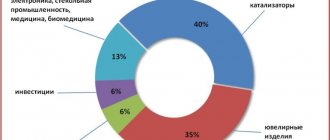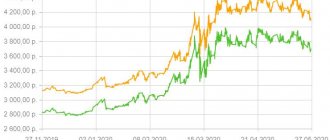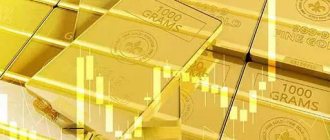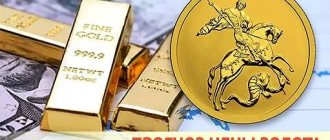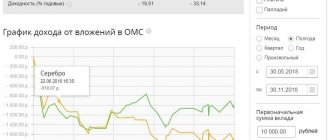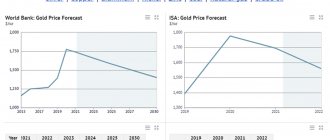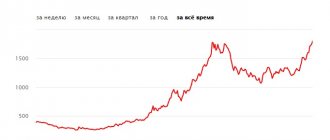Post updated: May 26, 2020
The gold rate in 2014 did not greatly please investors; after reaching its peak in March, it set a steady course of decline until the end of the year. The peak price was $1,365 per ounce, the lowest was $1,161. In this article we will review the forecasts given by experts for the rate of the yellow metal for last year and find out who was right and who was wrong.
We will also consider the basic rules of investing in precious metals. The chart below will help you fully track how the gold rate changed in 2014.
Change in gold rate over 5 years (USD/1 troy ounce, London fixing):
What influences the change in gold exchange rate?
The specificity of gold is that it is both a commodity and a financial instrument.
Therefore, the formation of its price is influenced by a combination of factors inherent to both goods and investment instruments. The former are influenced by market demand, the depletion of old deposits or the discovery of new ones, the emergence of new developments in the field of metal mining, and so on.
When considering gold as an investment instrument, global financial factors should be considered:
- Political or economic crises cause increased demand for gold, which in turn leads to its rise in price. The emergence of inflation in a country has the same consequences.
- The activities of central banks aimed at increasing the country's gold and foreign exchange reserves lead to its deficit and, accordingly, to an increase in its prices.
- The climate of the stock markets is also reflected in the price of gold.
- The value of the dollar is inversely proportional to the price of gold.
- Artificially created factors, such as agreements between manufacturers and speculative games, have an impact on the price.
In addition to the above, there are many other, at first glance, less significant factors that can, under certain circumstances, play a decisive role in determining the price of gold.
Your loan has been approved!
A History of the Falls and Amazing Rise of Gold and Silver Prices
Given what's happening in the markets right now, it's time to look at the history of the decline in gold and silver prices. Why did precious metals become cheaper, and for what reason did they subsequently break records? Let's try to answer these questions.
Despite the current volatility in US stock markets, what is happening with gold and silver is not out of the ordinary. There have been many periods in history when their prices dropped sharply. The reasons for these falls varied, as did their duration and depth.
However, later everything returned to normal. This has always happened. Situations differ only in how long it took to recover, and what was the magnitude of the subsequent increase in prices for these precious metals.
We will talk about three periods that are most similar to the current situation: the global financial crisis of 2008, the crisis of the 1970s. and the Great Depression. We deliberately ignore periods of bear markets or depreciation after major bull markets because, in our opinion, we are currently experiencing a crisis.
So let's analyze the severity, duration and level of subsequent rallies during these three major declines.
Global financial crisis of 2008
The global financial crisis of 2008, like the current crisis, was characterized by deflation.
The worst crash in stock markets occurred in October 2008. Gold and silver also fell sharply then, largely for the same reasons as now: investors needed liquidity. The yellow metal fell in price by 29.5% over 7 months (from March to October 2008, quotes fell from $1,000 to $700 per ounce). As today, investors have expressed their doubts about gold being a safe haven asset. Silver lost more in price: 57.6% over 7 months (from March to November 2008 it fell from 21 to 9 dollars per ounce). However, subsequently both metals regained their positions, and even more than that. The gold price increased by 166% in less than three years (from $700 in November 2008 to $1,900 per ounce in September 2011). Silver was luckier: the rate rose by 448% in 2 years and 6 months (from $9 per ounce in November 2008 to $48 per ounce in April 2011).
The lesson from the era of the global financial crisis is that gold and silver can lose value due to a sharp collapse in stock market indices. However, in such an environment, investors also tend to buy gold and silver, which ultimately leads to higher prices for precious metals. In other words, after the initial shock wears off and the race for liquidity is over, investors immediately rush to stock up on precious metals, which drives up prices.
Crisis of the 1970s
The 1970s were turbulent. Rampant inflation, rising unemployment, crashing stock markets, the US energy crisis and the Soviet invasion of Afghanistan.
Gold and silver fell in price against this background. At the time, no one could believe it, since precious metals should have behaved like defensive assets: rising in price when all the traditional assets around them were falling in price.
The gold price fell in 1975-1976. by almost 50% (from $195 in January 1975 to $105 per ounce by September 1976). This decline was doubly curious because it began almost immediately after US citizens were again allowed to own gold (on January 1, 1975). The development must have puzzled many investors who thought the rate would rise due to increased demand as a result of the new law.
Silver lost less value than gold, but the decline lasted longer (from $6.75 per ounce in March 1974 to $3.75 per ounce by February 1976). The silver rate was more volatile. Investors couldn't understand what was happening. There was a crisis everywhere, and gold became a legal commodity again, but the expected rally was not observed.
However, the fall did not last long. Despite investor disappointment, as the crisis was overcome, purchases of gold and silver increased and prices rose significantly.
Gold reached a price “bottom” in the late summer of 1976, and then, over three years, the rate increased by 440% (from $110 per ounce in August 1976 to $850 per ounce by January 1980).
Silver also regained lost ground, rising from $3 an ounce in January 1976 to $49 an ounce by January 1980. Over four years, the gray metal increased in price by 943%.
The lesson from this period is similar to what we learned from the aftermath of the global financial crisis. Precious metals collapsed in the initial shock to the economy and markets. However, they subsequently recovered in price as more and more investors felt the need for protective assets. Those who did not panic and did not listen to the pessimistic sentiments of others received a reward. It was worth the wait.
The Great Depression
One might think that there is no point in considering the Great Depression, since the price of gold was fixed, the US was on the gold standard, and the public was prohibited from owning the yellow metal due to an executive order by President Franklin Delano Roosevelt in 1933.
However, American investors could own shares in gold mining companies. They were used as substitutes for gold, which could not be purchased in physical form. From 1929 to 1933 shares of , the largest gold producer in the United States, rose 474%. Shares of Canada's largest gold miner, Dome Mines, rose 558%. At the same time, the Dow Jones stock index fell by 73%.
In addition, both companies increased their dividends during the Great Depression: Homestake's increased from $7 to $15 per ounce, and Dome's from $1 to $1.8 per ounce.
This can be partly explained by the fact that gold miners could sell gold at a fixed price set by the government, which was beneficial to them because it reduced operating costs. During the period of market collapse and rising unemployment, investors preferred to buy shares of gold mining companies against the backdrop of one of the largest deflations in history.
It's interesting to note that Homestake shares rose in value faster than other companies for 15 years! From 1925 to 1940 they rose 10-fold, while the Dow showed no growth.
Now, of course, we are not observing such indicators, and it is difficult to say what would have happened with a non-fixed gold rate in a depression. However, given that the only way to own gold in the US was through shares of gold mining companies, it can be said that once the forced liquidation ended, gold would have recovered in value.
Should we expect further declines in gold and silver prices?
There are no absolutely similar falls and rises in prices for precious metals. The current fall has its own specifics. However, the history of three major declines shows that gold and silver react negatively to crises, but then prices exceed all expectations. This happened during periods of both inflation and deflation. Although both precious metals look good in an inflationary environment, they eventually start to rise due to the crisis.
Something similar is happening now. History teaches that, despite the sales of gold and silver, the crisis will attract a large number of investors to precious metals, and this in any case will significantly affect their prices.
Exchange rate dynamics over 5 years
- Over five years, from 2009 to 2014, the gold rate increased from 840 to 2,200 rubles per gram. At the same time, the price reached its peak value in 2012-2013, approaching 1,800 rubles per gram.
- After this, the rate began to fall, fluctuating slightly around the $1,300 mark throughout 2012-2013.
- In mid-November 2014, the price dropped to 1,130 rubles, which was followed by a sharp jump upward.
Exchange rate dynamics over 10 years
- In 2004, the gold rate started at 360 rubles per gram and maintained its position for a relatively long time until 2006, after which a gradual increase in value began.
- At the beginning of 2008, the price increased to 750 rubles per gram, fluctuating slightly until 2009.
- The beginning of 2010 was marked by a sharp jump in value to 1,100 rubles, after which regular fluctuations and an increase in the price of gold were observed until the end of 2012.
- This was followed by a drop in price until the beginning of 2014 and its growth thereafter.
Important aspects of investing in gold
Unfortunately, it's not that simple. Counting on quick profits from investing in gold is risky and, as practice shows, useless.
Your own knowledge in the field of exchange trading in precious metals is necessary; in cases where this is not enough, you can listen to the forecasts of market analysts.
To reduce risks, be sure to decide on the timing of investments, study current quotes, gold rates for 2014 and earlier dates. In general, gold is slowly but rising in price.
Investing in gold remains a reliable investment option. It is less exposed to the risk of inflation and global economic disasters than other types of investments.
If you invest a significant amount in gold at once, the profit will be very noticeable. But the risk is definitely greater. If the investment is small, then the profit will come over a longer period.
Investment in gold can be done in different ways. Firstly, you can purchase investment coins and gold bars. You can also open an impersonal metal account.
The advantage of purchasing gold coins is that 18% VAT is not paid for them; the price per gram will be slightly more expensive than in bullion. Again, the coins have a collectible value that only increases over the years.
Investment coins St. George the Victorious.
Coins can be carried with you, they are more convenient to store, but bullion will only have to be stored in a safe.
In recent years, the demand for metal accounts has been growing. When you open it, you will not need to pay VAT, managing your investments is disproportionately simpler and more convenient through the Internet banking system, which allows you to quickly respond to changes in quotes.
But we must not forget about certain risks of investing in gold.
The rest of the world's currencies do not experience such significant jumps as are characteristic of gold. That is why short-term deposits more often suffer losses. For example, the gold rate was only able to overcome the negative dynamics as of December 2014 and will rise slightly.
It is well known that in Russia, in general, gold when purchased is valued much more expensive than when sold. Therefore, profit is made if the gold rate soars quickly.
If you nevertheless decide to invest money in gold, then it is worth following for some time the changes in the gold exchange rate and the forecasts of analysts, although no one can reliably predict it. But it’s still worth sticking to the opinions of people who understand this.

